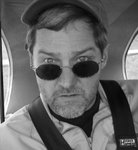by Paul Berge
.
.
Looking down from America’s skies you see a country that spreads itself open like a family album. As a flight instructor with a passion for antique airplanes, I cruise across the middle of the nation between the Mississippi and Missouri Rivers rarely above the height of my fellow travelers--the red-tailed hawks and turkey vultures. From 500 feet above the cornfields, rolling pastures, and second-growth forests, we literally have a birds-eye view of a country that often forgets to look up.
It’s a country that sprawls itself out like a fat uncle beneath a shade tree after a summer picnic—content and well fed.
It’s a country that loves its parks and scenic overlooks, yet cuts great ribbons of Interstate highways through the glory of the prairie so that those on the one coast won’t dawdle getting to the other.
.
And from the altitude of the bald eagles that migrate through Iowa each year, I throttle back my 56-year old airplane and drift with a uniquely American wind over small towns that have been missed by the freeways and remain the resting stops of faded souls.
And from the altitude of the bald eagles that migrate through Iowa each year, I throttle back my 56-year old airplane and drift with a uniquely American wind over small towns that have been missed by the freeways and remain the resting stops of faded souls.
From the Midwestern sky I track the Mormon Trail and can follow the dozens of abandoned railroad lines that once linked countless forgotten prairie towns together so long ago. From  just above the noise of the 21st century, seated behind a 65-horsepower engine, with two cloth wings stretching from my core, I fly through this sky that has been the dome of a vast continent since long before anyone envisioned our manifest destiny.
just above the noise of the 21st century, seated behind a 65-horsepower engine, with two cloth wings stretching from my core, I fly through this sky that has been the dome of a vast continent since long before anyone envisioned our manifest destiny.
 just above the noise of the 21st century, seated behind a 65-horsepower engine, with two cloth wings stretching from my core, I fly through this sky that has been the dome of a vast continent since long before anyone envisioned our manifest destiny.
just above the noise of the 21st century, seated behind a 65-horsepower engine, with two cloth wings stretching from my core, I fly through this sky that has been the dome of a vast continent since long before anyone envisioned our manifest destiny. .
The American sky is unlike any other. When I’m aloft, alone or with a student, with the wind singing through the struts and into the cockpit, I glance at the few ancient instruments on the airplane’s panel and feel the connection with other American fliers who’ve lived in these skies--Lindbergh, Earhart, or Ernest Gann. We’ve shared a sky that’s less than a half-mile above the real estate we call our nation. We who fly on fabric wings live in a stratum that time has graciously overlooked. For the few hours that the fuel tank allows us to stay in that sky we’re the guests of something truly ethereal that so few Americans ever touch. Yet, oddly, this album of beauty is there for the taking. It’s open to all who believe in this country’s ability to amaze, inspire and—inside this old airplane—rejuvenate. It’s there provided we Americans never forget how to fly.
--Paul Berge
The American sky is unlike any other. When I’m aloft, alone or with a student, with the wind singing through the struts and into the cockpit, I glance at the few ancient instruments on the airplane’s panel and feel the connection with other American fliers who’ve lived in these skies--Lindbergh, Earhart, or Ernest Gann. We’ve shared a sky that’s less than a half-mile above the real estate we call our nation. We who fly on fabric wings live in a stratum that time has graciously overlooked. For the few hours that the fuel tank allows us to stay in that sky we’re the guests of something truly ethereal that so few Americans ever touch. Yet, oddly, this album of beauty is there for the taking. It’s open to all who believe in this country’s ability to amaze, inspire and—inside this old airplane—rejuvenate. It’s there provided we Americans never forget how to fly.
--Paul Berge
.
© 2002, Paul Berge, all rights reserved.
Photo courtesy of Curtis Kelly. Taken over Blakesburg, Ia., (IA27)
Photo courtesy of Curtis Kelly. Taken over Blakesburg, Ia., (IA27)

No comments:
Post a Comment